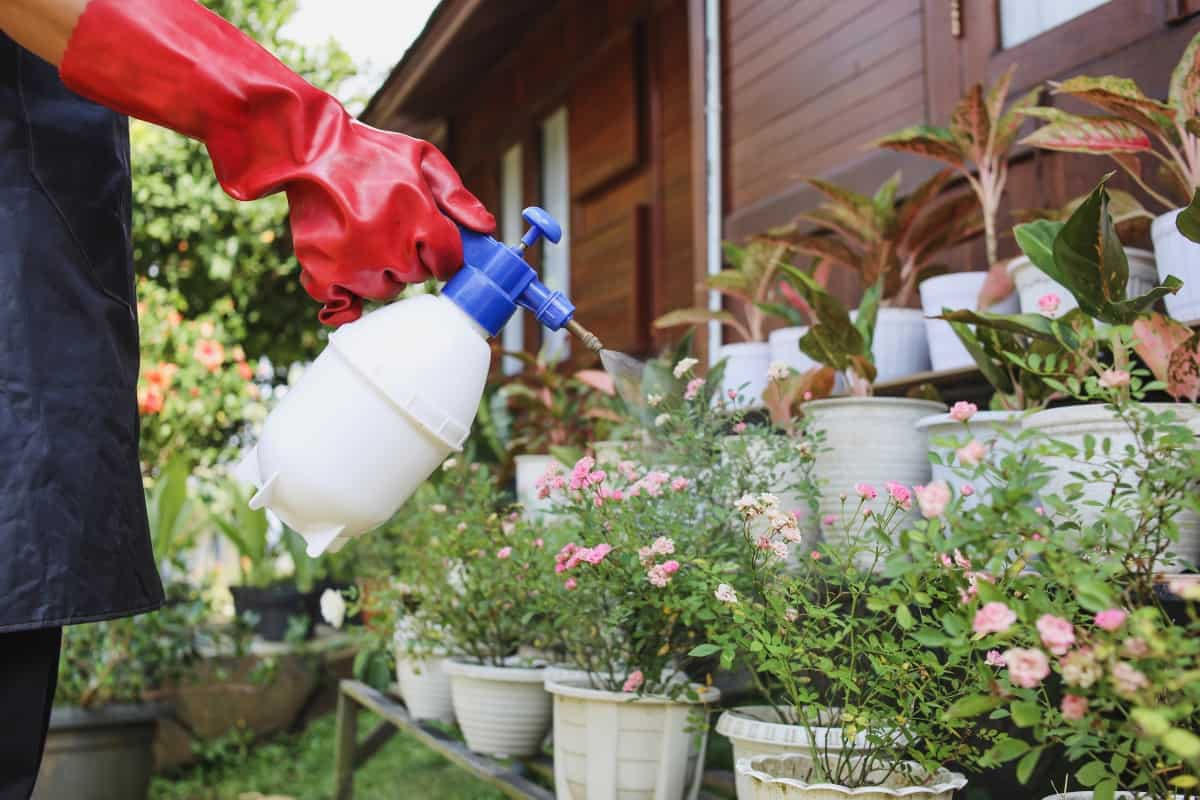Caterpillars can be a persistent nuisance in gardens, causing damage to your plants and disrupting the overall health of your garden. Instead of resorting to chemical pesticides, you can try effective homemade remedies to get rid of caterpillars naturally. Here are ten best homemade remedies for caterpillars in your garden using simple recipes.

10 Best Homemade Remedies for Caterpillars
Neem Oil Spray
Create a simple and effective homemade remedy to eliminate caterpillars from your garden using a Neem Oil Spray. Mix neem oil (one tablespoon) with one liter of water in a spray bottle. Add some dish soap liquid to help the solution adhere to the caterpillars. Shake well and spray the affected plants, focusing on the undersides of leaves where caterpillars often hide.
Neem oil acts as a natural insecticide, disrupting the feeding and growth of caterpillars while being safe for plants. Apply the solution every 7-14 days or after rainfall to ensure continuous protection. This eco-friendly remedy helps maintain a healthy garden without harmful chemicals.
Diatomaceous Earth
Diatomaceous Earth (DE) controls caterpillars in home gardens by dehydrating and disrupting their exoskeletons. DE is a powdery substance comprising fossilized diatoms with microscopic sharp edges. When caterpillars come into contact with DE, it adheres to their bodies, absorbing lipids and causing dehydration, ultimately leading to their demise. The abrasive nature of DE physically damages the protective layer of insects, impairing their ability to retain moisture. This natural and non-toxic method provides an effective and environmentally friendly solution for controlling caterpillar infestations in the home garden,
Garlic Spray
Ward off caterpillars from your garden using a homemade Garlic Spray. Blend 3-4 cloves of garlic with 2 cups of water and strain the mixture to extract the liquid. Add a teaspoon of dish soap, which acts as an adhesive, to the garlic liquid. Dilute this concoction by combining it with a gallon of water.
In case you missed it: How to Control Cabbage Worms and Caterpillars: Organic, Chemical, Biological, and Cultural Control Methods

Pour this liquid solution into a spray bottle and generously apply it to the affected plants, especially on the undersides of leaves where caterpillars tend to hide. The pungent smell of garlic repels caterpillars, preventing them from feeding on your plants. Reapply the spray every week or after rainfall for sustained effectiveness. This natural and easy-to-make remedy helps protect your garden without harmful chemicals.
Bacillus Thuringiensis (BT)
Create an effective homemade remedy for caterpillars in your garden using Bacillus thuringiensis (BT), a natural bacteria that targets these pests. Mix 1-2 tablespoons of BT powder or liquid concentrate with 4 liters of water in a sprayer. Shake well to ensure proper dispersion.
Spray the solution onto the affected plants, covering both the upper and lower surfaces of the leaves. BT is a safe and environmentally friendly option, specifically designed to target caterpillars without harming beneficial insects. Apply the solution every 7-14 days or as needed, especially during the caterpillar’s active feeding periods. This targeted approach provides a natural and efficient solution for protecting your garden from caterpillar damage.
Companion Planting
Employ the power of companion planting to deter caterpillars in your garden. Integrate plants known for repelling caterpillars alongside susceptible crops. For instance, plant aromatic herbs like basil, dill, and cilantro near susceptible plants. These herbs emit scents that caterpillars find unpleasant. Marigolds, with their natural pest-repelling properties, also make excellent companions. Additionally, consider planting vegetables like tomatoes or peppers, which can act as a natural deterrent.
Create a diverse and balanced ecosystem to attract beneficial insects (predatory wasps, and ladybugs) that feed on caterpillar larvae. Companion planting not only discourages caterpillars but fosters a healthier garden overall. Experiment with combinations that suit your specific garden and observe the positive impact of this natural and sustainable approach to pest management.
Manual Removal
Combat caterpillars in your garden through manual removal. Regularly inspect plants for the presence of caterpillars and pick them off by hand, dropping them into a soapy water solution to prevent re-infestation. Pay attention to the undersides of leaves where caterpillars often hide. Encourage beneficial insects like ladybugs and spiders that naturally prey on caterpillars.
In case you missed it: Can Vinegar or Baking Soda Kill Leaf Miners: How About Neem Oil?

This hands-on approach not only controls the infestation but also allows you to monitor your garden closely. Combine manual removal with companion planting and maintaining a balanced ecosystem to enhance your garden’s resilience against caterpillar damage. This low-tech, organic method ensures a caterpillar-free garden while minimizing environmental impact.
Spicy Pepper Spray
Deter caterpillars in your garden with a simple and spicy pepper spray. Pour 2 cups of water, 1-2 hot peppers (such as jalapeños or cayenne), and a teaspoon of dish soap in a blender. Blend them until smooth, then strain the mixture to extract the liquid. Fill this liquid into a spray bottle and apply it to your plants, focusing on areas where caterpillars are present.
The heat from the peppers irritates and repels caterpillars, protecting your garden naturally. Reapply the spicy pepper spray every week or after rainfall for continued effectiveness. This homemade remedy is an eco-friendly solution that adds a kick to your pest control strategy.
Floating Row Covers
Shield your garden from caterpillars with floating row covers, a physical barrier that prevents these pests from reaching your plants. Purchase lightweight, breathable row cover fabric and drape it over your crops, securing the edges to the ground with stakes or soil. Ensure the covers are well-sealed to prevent caterpillars from finding their way underneath.
This method not only physically blocks caterpillars but also allows sunlight, air, and water to reach your plants. Regularly inspect the covers for tears or gaps and repair them as needed. Floating row covers are a non-chemical and effective way to safeguard your garden, offering a practical and sustainable solution for caterpillar control.
Vinegar Solution
Create a homemade caterpillar-repelling solution using vinegar. Mix water and white vinegar in equal ratios in a spray bottle. Add some mild dish soap liquid and shake the solution well. Spray this mixture directly onto the affected plants, focusing on areas where caterpillars are present.
The acidity of vinegar acts as a deterrent, making the environment less favorable for caterpillars. Reapply the vinegar solution regularly, especially after rainfall or watering. This simple and cost-effective remedy provides a natural way to protect your garden from caterpillar damage without resorting to harsh chemicals.
Beneficial Insects
Harness the power of beneficial insects to control caterpillar populations in your garden. Attract natural predators like ladybugs, lacewings, and parasitic wasps by planting nectar-rich flowers such as marigolds, dill, and alyssum. These beneficial insects feed on caterpillars and their larvae, helping to maintain a healthy balance in your garden. Avoid using broad-spectrum insecticides that may harm these helpful creatures.
In case you missed it: How to Get Rid of Leaf Miners on Citrus Trees: Naturally, Organically, and Chemically

Additionally, consider introducing natural enemies like Trichogramma wasps, which lay their eggs in caterpillar eggs, preventing their development. Encouraging a diverse and thriving ecosystem in your garden promotes an automated environment, keeping caterpillar populations in check without the need for chemical interventions. This approach supports a sustainable and eco-friendly method of pest management.
Conclusion
In conclusion, these ten homemade remedies offer effective, eco-friendly solutions to combat caterpillars in your garden. From neem oil and diatomaceous earth to garlic spray and companion planting, these simple recipes provide natural alternatives to chemical pesticides. With the right method, you can have a thriving garden while minimizing the impact on the environment.
- Feed Your Flock for Less: Top 10 Tips to Save on Chicken Feed
- Ultimate Guide to Ossabaw Island Hog: Breeding, Raising, Diet, and Care
- Hatching Answers: The Top 10 Reasons Your Chickens Aren’t Laying Eggs
- Eggs and Economics: Breaking Down the Cost of Raising Backyard Chickens
- Defend Your Greens: Proven Methods to Keep Iguanas Out of Your Garden